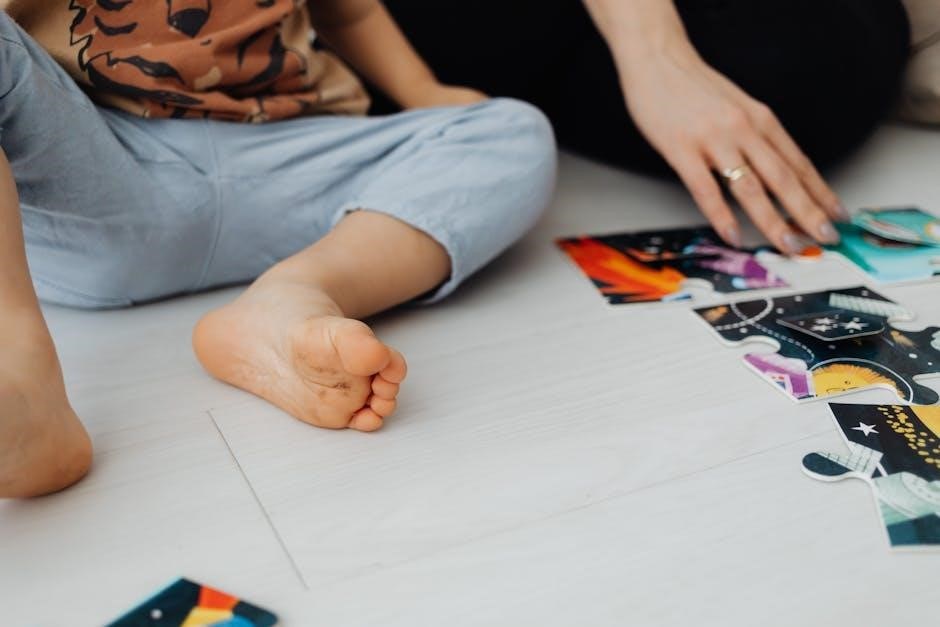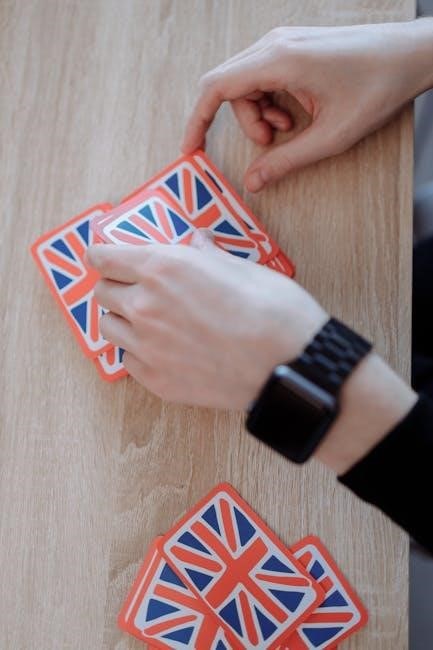Hand and Foot is a popular North American card game similar to Canasta. It uses multiple decks, including Jokers, and involves creating sets to eliminate cards.
1.1 Brief History and Overview
Hand and Foot is a North American card game closely related to Canasta. Originating in the mid-20th century, it gained popularity for its dynamic gameplay and team-based structure. Typically played with 4 to 8 players, the game uses five to six decks, including Jokers. The objective is to be the first to eliminate all cards by creating valid melds. Its unique ‘hand and foot’ mechanic adds a strategic layer, distinguishing it from other rummy-style games. Over time, various house rules have emerged, enhancing its appeal.
1.2 Why It’s Popular
Hand and Foot is popular due to its engaging team-based gameplay and strategic depth. The use of multiple decks and Jokers adds excitement, while the objective of creating melds challenges players. Its versatility accommodates 2 to 8 players, making it ideal for various social settings. The game’s simplicity for beginners, combined with its depth for experienced players, fosters a sense of community and healthy competition, contributing to its enduring appeal.

Setup and Equipment
Hands and Foot requires a card table, comfortable seating, and multiple decks. Shuffle all cards together thoroughly before dealing. The number of decks depends on players.
2.1 Number of Players and Teams
Hand and Foot is typically played with 4 to 8 players, divided into teams of 2 to 4 members. Teams work together to meld cards and score points. The game can also be played individually, but team play is more common. The number of decks used scales with the number of players, ensuring each player has a “hand” and “foot” set of cards. The objective is to eliminate all cards first, either individually or as a team, to win the round.
2.2 Deck Requirements
Hand and Foot requires 5 to 6 standard decks of 52 cards, including Jokers. Each deck must include Jokers, as they serve as wild cards. The number of decks used depends on the number of players, ensuring each player receives both a “hand” and a “foot.” The decks are shuffled together to create a large pool of cards, allowing for dynamic gameplay and multiple melding opportunities. Jokers and wild cards add strategy and flexibility to the game.

Card Rankings and Special Cards
Card rankings follow the standard order, with Jokers acting as wild cards. These special cards can represent any card needed, enhancing strategic options during gameplay.
3.1 Card Values
In Hand and Foot, cards are valued based on their rank, with Aces, 2s, and 3s holding unique point values. Jokers and wild cards are high-value, aiding in melding. Each card’s value contributes to the player’s score when melded, emphasizing strategic planning to maximize points. Understanding these values is crucial for effective gameplay and scoring.
3.2 Role of Jokers and Wild Cards
Jokers and wild cards play a crucial role in Hand and Foot, acting as substitutes for any card to complete melds. They can be used strategically to form sets or runs, but cannot be used in a set of three identical cards. Wild cards add flexibility to gameplay, allowing players to overcome missing cards. Their ability to represent any card makes them highly valuable, especially in tight situations, and they are essential for competitive play.

Gameplay Overview
Hand and Foot is played in rounds with teams aiming to meld cards to eliminate their hand and foot. Strategy and teamwork are key to success.
4.1 Structure of a Round
A round begins with dealing cards into a hand and foot for each player. The hand is played first, followed by the foot after the hand is exhausted. Players take turns drawing cards and forming melds. Each round ends when a player melds all their cards, scoring points for their team. The goal is to complete melds strategically to maximize points while disrupting opponents. Rounds are independent, but the highest score after four rounds determines the winner.
4.2 Phases of Play
The game progresses through distinct phases. First, cards are dealt into a hand and foot for each player. Play begins with the hand, where players draw cards, form melds, and discard. Once the hand is exhausted, the foot is played similarly. The round ends when a player melds all their cards, triggering the scoring phase. Each phase requires strategic planning to maximize points and disrupt opponents, ensuring dynamic and engaging gameplay throughout the round.

Basic Rules
Players must draw and discard cards, forming valid melds of sets or runs. Jokers are wild, and a minimum number of cards must be laid down initially.
5.1 Drawing Cards
Players begin by drawing cards to form their initial meld. Each turn, a player draws one card from the deck or takes the entire discard pile if they can use the top card. Jokers act as wild cards, helping complete melds. Drawing continues until players form valid sets or runs. The ability to strategically draw and use cards is key to building melds and winning the game. Proper card management ensures players can eliminate their hand and foot efficiently.
5.2 Melding Cards
Melding is the process of laying down sets or runs of cards to earn points. A valid meld consists of three or more cards of the same rank (sets) or sequential cards of the same suit (runs). Jokers and wild cards can substitute for missing cards in a meld. Players must declare their melds clearly and place them face-up. Each meld must total at least 50 points to be laid down initially. Melding strategically helps players eliminate their hand and foot efficiently.

Scoring System
Points are awarded for valid melds, with bonuses for going out first. Penalties apply for unused cards. The team with the highest score after four rounds wins.
6.1 Points for Melds
In Hand and Foot, points are awarded based on the type and rank of cards in a meld. Jokers and wild cards are worth the most, followed by Aces, face cards, and numbered cards. Each meld must meet specific requirements to score. Bonus points are given to the first player to meld and for going out. Teams earn points for valid melds, while penalties apply for unused cards at the end of the round. Strategy revolves around maximizing points through efficient melding.
6.2 Bonuses and Penalties
Bonuses and penalties play a crucial role in scoring. A bonus is awarded to the first player to meld all their cards, while penalties apply for holding certain cards at the end of the round. Red threes are a key penalty card, each deducting significant points. Additionally, any unmelded cards in a player’s hand or foot result in point deductions. Teams must balance their strategy to maximize bonuses while minimizing penalties to maintain a competitive edge in the game.
Strategy and Tips
Strategy involves planning ahead, coordinating with teammates, and managing cards wisely to create melds quickly. Smart card management and disruptive tactics can outmaneuver opponents effectively.
7.1 Building Melds
Building melds is central to success in Hand and Foot. Melds are sets of three or more cards of the same rank or sequences of sequential ranks. Players must strategically plan which cards to keep and discard to form valid melds quickly. Communication with teammates is crucial to coordinate melds effectively. Using Jokers as wild cards can help complete tricky melds. Always aim to meld early to minimize penalties and maximize scoring opportunities.
7.2 Disrupting Opponents
Disrupting opponents is a key strategy in Hand and Foot. By holding onto cards that complete their melds, you can delay their progress. Use wild cards like Jokers to interfere with their sets. Discarding strategically can force opponents to pick up unwanted cards, increasing their hand size. Pay attention to their discard pile to anticipate their moves and block potential melds. Effective disruption can pressure opponents into mistakes, giving you an edge in the game.
Variations and House Rules
Variations include different player numbers, deck counts, and scoring systems. House rules may add bonuses or penalties, enhancing the game’s adaptability and fun.
8.1 Different Ways to Play
The Hands and Feet card game offers various ways to play, accommodating different preferences and group sizes. It can be played with 2 to 6 players, using 4 to 6 decks respectively. Team play is common, but individual play is also an option. Scoring can vary, with some games emphasizing speed and others focusing on strategy. House rules often include bonuses for specific melds or penalties for leftover cards. Some variations introduce wild cards or special rounds to increase complexity and excitement.
8.2 Custom Rules
Players often introduce custom rules to enhance gameplay. Some groups vary the number of rounds or adjust scoring systems. Others modify how wild cards function or add bonus points for specific meld combinations. Custom rules can also include penalties for holding certain cards or incentives for rapid play. These variations allow players to tailor the game to their preferences, making it more enjoyable and challenging. House rules often evolve based on group dynamics and playstyle.
Learning the Game
Learning Hand and Foot is straightforward, starting with basic strategies like forming melds and understanding card values. Newcomers can quickly grasp the fundamentals, making it accessible to all skill levels while mastering techniques takes time and practice.
9;1 Getting Started
Getting started with Hand and Foot involves understanding the basic rules and objectives. Begin by familiarizing yourself with the deck and card rankings. Start with a small group or online tutorials to learn the mechanics of melding and scoring. Practice shuffling and dealing the cards to ensure smooth gameplay. Pay attention to how the hand and foot sets are used separately. Start with short rounds to build confidence and gradually increase complexity as you gain experience. Consistent practice will help you master the game.
9.2 Common Mistakes
New players often make mistakes such as forgetting to use Jokers effectively or discarding cards needed for melds. Another common error is failing to properly separate the hand and foot sets, leading to confusion. Some players rush to meld without planning ahead, while others neglect to communicate strategies in team play. Additionally, miscounting points or misunderstanding the scoring system can lead to unnecessary penalties. Avoiding these errors requires attention to detail and practice.
Hand and Foot is a delightful game that combines strategy, teamwork, and fun, perfect for players of all skill levels. Give it a try today!
10.1 Final Thoughts
Hand and Foot is a captivating card game that blends strategy with excitement, making it a favorite for many. Its unique structure, requiring players to manage both their “hand” and “foot,” adds a layer of complexity that keeps the game engaging. Whether you’re a seasoned player or a newcomer, the combination of teamwork and individual skill ensures a fun and challenging experience. It’s a game that fosters camaraderie and sharpens your strategic thinking, making it a great addition to any game night.
10.2 Encouragement to Play
Hand and Foot is a game that offers something for everyone, making it an excellent choice for family gatherings, casual meetups, or competitive play. Its strategic depth and social interaction create lasting memories and foster teamwork. Whether you’re looking to unwind or challenge yourself, this game promises endless enjoyment. Give it a try, and you’ll soon discover why it’s a beloved favorite among card game enthusiasts!